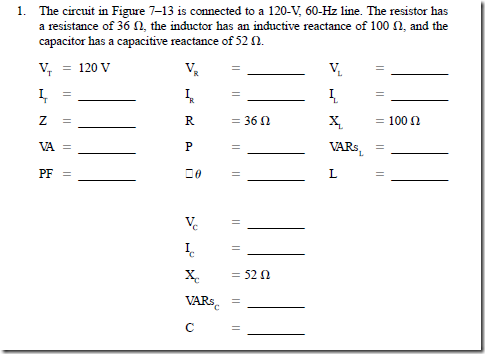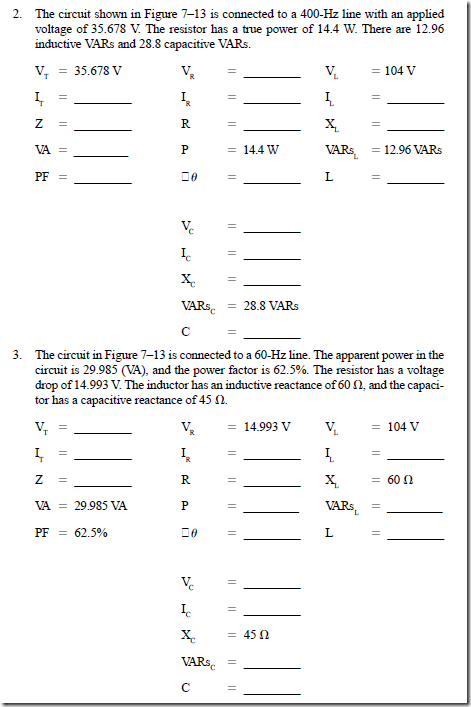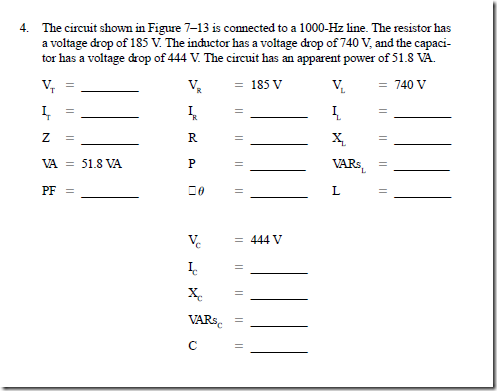RESONANCE IN SERIES CIRCUITS
In the solution to problem 1 in this unit, the inductive reactance was greater than the capacitive reactance. As a result, there was a lagging power factor. In problem 2, the capacitive reactance is larger than the inductive reactance and the power factor is leading.
If the inductive reactance equals the capacitive reactance, then V equals V . Because these voltages are 180° out of phase with each other, they will cancel exactly. The effects of both the inductive reactance and the capacitive reactance are now removed from the
series circuit. Thus, only the resistance of the circuit remains to limit the current. A circuit for which these conditions are true is called a resonant circuit. The full line voltage appears across the resistance component.
PROBLEM 2
Statement of the Problem
A resonant series circuit is shown in Figure 7–6. The phase angle between the current and the line voltage for this circuit is zero. The power factor is 1.00.
Another way of looking at this circuit is to recognize that the value of the magnetizing VARs required by the coil is equal to the magnetizing VARs supplied by the capacitor. These values cancel each other so that no VARs appear at the input terminals.
Determine the following quantities for the resonant series circuit in Figure 7–6:
1. The impedance
2. The current
3. The voltage across the resistor
4. The voltage across the coil
5. The voltage across the capacitor
6. The loss in the resistor, in watts
7. The magnetizing VARs required by the coil
8. The magnetizing VARs supplied by the capacitor
9. The input in volt-amperes
10. The power factor and the phase angle for the series circuit Then develop the vector diagram for the circuit.
Solution
1. The impedance of a resonant circuit is the same as the resistance of the circuit. The formula for impedance is
3. The voltage across the total resistance of a resonant series circuit equals the line volt- age. It is assumed that there is no resistance in either the coil or the capacitor. The voltage across the lamp load is
9. The input volt-amperes for the series circuit is the product of the line voltage and the current. The input volt-amperes and the true power are the same in a series resonant circuit:
VA = VI = 120 X 5 = 600 VA
10. Because the true power and the input volt-amperes are the same for this circuit, the power factor is unity. A unity power factor is also obtained from the ratio of the resistance of the resonant series circuit and the input impedance:
THE PROPERTIES OF SERIES RESONANCE
Figure 7–8 summarizes the properties of series resonance. Each curve is based on the mathematics of series resonance.
Current versus Frequency (Figure 7–8C)
The impedance/frequency waveform of Figure 7–8B is useful in interpreting the cur- rent versus the frequency waveform in Figure 7–8C.
According to the equation I = V/Z, as the impedance rises, the current falls. The reverse is also true. This means that the current curve is the reciprocal or inverse of the impedance curve.
Graphically, it was convenient to use the impedance curve to explain the current curve. In the laboratory, however, it is easier to vary the frequency and note ammeter readings than it is to vary the frequency and calculate impedance values.
Power Factor versus Frequency (Figure 7–8D)
The formula that defines the power factor curve is PF = R/Z. This formula was selected because it lends itself to the impedance curve.
At frequencies below resonance, the equation PF = R/Z shows the power factor to be inversely proportional to impedance. For high values of impedance, where the frequencies are below resonance, the power factor becomes small. Therefore, for small values of R, it is possible to obtain a power factor near zero. The cosine of the phase angle is zero. Thus, the phase angle equals 90°. Because the frequency is below resonance, the circuit is capacitive, and the power factor is leading or positive.
For frequencies at resonance, Z = R. Thus, the equation PF = R/Z becomes unity.
The angle whose cosine is unity is 0°.
For frequencies above resonance, the equation PF = R/Z has the same values as it does when the frequencies are below resonance. In this case, the circuit is now inductive and the power factor is lagging or negative.
SUMMARY
• In an inductive circuit, the current lags the applied voltage across the inductor.
• In a capacitive circuit, the current leads the applied voltage across the capacitor.
• The net reactance of an RLC series circuit is
• The circuit power factor (PF) and the phase angle (ÐO) are determined by the resistance and the capacitive or inductive reactance that is not canceled.
• At the resonant frequency
1. The phase angle between the current and the line voltage is zero.
2. The power factor is 1.00, and the input volt-amperes and the true power are the same: VA = VI. Also,
Achievement Review
1. A series circuit consists of a 100-n resistor, a coil with an inductance of 0.5 H and negligible resistance, and a 40-µF capacitor. These components are connected to a 115-V, 60-Hz source.
a. Determine
1. the impedance of the circuit.
2. the current in the circuit.
3. the power factor and the phase angle of the circuit (indicating whether the power factor and the phase angle are leading or lagging).
b. Draw a vector diagram for the circuit.
2. A coil, having a resistance of 100 n and an inductance of 0.2 H, is connected in series with a 20-µF capacitor across a 120-V, 60-Hz supply. Determine
a. the impedance of the circuit.
b. the current.
c. the power factor of the circuit.
d. the voltage across the capacitor.
e. the instantaneous maximum voltage across the terminals of the capacitor.
3. In the series circuit shown in Figure 7–9, determine
a. the total impedance.
b. the voltage drop across the coil.
c. the capacitance required to obtain resonance.
4. a Explain what is meant by the term resonance when used with ac series circuits.
b. What precaution must be observed when working with series circuits having inductive and capacitive circuit components?
5. For the series circuit shown in Figure 7–10, determine
a. the frequency at which this circuit will resonate.
b. the value of the impedance of the circuit at resonance.
c. the power factor at resonance.
d. the voltage across the capacitor at the resonant frequency.
6. The starting winding circuit of a capacitor-start, induction-run motor consists of a 15-n resistance and a 20-n inductive reactance. These components are in series with a 50-j.LF capacitor. The circuit is connected to a 120-V, 60-Hz source.
Determine
a. the impedance of the series circuit.
b. the current.
c. the true power.
d. the power factor.
7. A simple tuning circuit consists of a 100-µH inductance, a 200-pF capacitance, and a 20-n resistance connected in series. The voltage from the antenna to ground is 100 µV.
a. Determine the resonant (natural) frequency of the circuit.
b. Determine the current, in microamperes, at the resonant frequency.
8. For the circuit given in question 7, determine the voltage across the coil at the resonant frequency.
9. In the circuit shown in Figure 7–11, determine the voltmeter reading for each of the following conditions:
a. When point A is grounded
b. When the ground is removed from A and placed at B
c. When there is no ground at either point A or point B, but there is a “break” in the coil
10. For question 9, determine the voltmeter reading for each of the following conditions:
a. There is no ground at either point A or point B, and the coil and capacitor are in good condition, but the resistor is completely “shorted.”
b. There are no faults in the circuit.
11. A single-phase, 115-V, 60-Hz motor uses a 100-µF capacitor in series with the starting winding. The starting winding has an effective resistance of 5 n and an inductance of 0.01 H. Determine
a. the total impedance, in ohms, of the starting winding circuit, including the series-connected capacitor.
b. the current.
c. the voltage across the capacitor.
12. Draw a labeled vector diagram for the circuit in question 11.
13. A coil has a resistance of 100 n and an inductance of 0.2 H. This coil is connected in series with a 20-µF capacitor across a 120-V, 60-Hz supply. Determine
a. the total impedance of the series circuit.
b. the current.
c. the power factor and the power factor angle for the series circuit.
d. the impedance of the coil.
e. the power factor and the power factor angle for the coil.
14. Draw a labeled vector diagram for the series circuit in question 13.
15. Using the values given on the circuit diagram in Figure 7–12, determine
a. the impedance of the coil.
b. the resistance of the coil.
c. the inductive reactance of the coil.
d. the power factor and the phase angle for the coil.
16. Using the circuit given in question 15, determine
a. the impedance of the entire series circuit.
b. the power factor and the power factor angle for the series circuit.
c. the loss in volts across the resistor and across the capacitor.
d. the inductance of the coil, in henrys.
e. the capacitance of the capacitor, in microfarads.
17. Construct a vector diagram for the circuit in question 16.
PRACTICE PROBLEMS FOR UNIT 7
Resistive, Inductive, Capacitive Series Circuits
Find the missing values in the following circuits. Refer to Figure 7–13 and the formulas listed in the Resistance, Inductive, Capacitive (Series) section of Appendix 15.
























